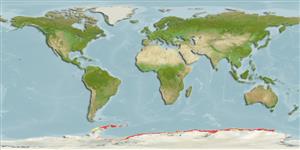Environment: milieu / climate zone / depth range / distribution range
Ekologi
laut dasar (demersal); kisaran kedalaman 140 - 1405 m. Polar; 60°S - 78°S
Southern Ocean: East Antarctica (Ross Sea, Davis Sea, Queen Maud Land), South Shetland Islands and South Orkney Islands.
Size / Weight / umur
Maturity: Lm ? range ? - ? cm
Max length : 21.0 cm TL jantan/; (Ref. 5181); Berat maksimum terpublikasi: 131.00 g (Ref. 124149)
Individuals over 10 cm SL feed primarily on mysids and to a lesser extent on isopods. Fish below 10 cm SL feed almost exclusively on gammaridean amphipods (Ref. 5181).
Life cycle and mating behavior
Maturities | Reproduksi, perkembang biakan | Spawnings | Egg(s) | Fecundities | Larva
Eakin, R.R., 1990. Artedidraconidae. p. 332-356. In O. Gon and P.C. Heemstra (eds.) Fishes of the Southern Ocean. J.L.B. Smith Institute of Ichthyology, Grahamstown, South Africa. (Ref. 5181)
Status IUCN Red List (Ref. 130435)
ancaman kepada manusia
Harmless
penggunaan manusia
Perikanan: tidak ada kepentingan
Alat, peralatan
laporan khas
muat turun XML
Sumber internet
Estimates based on models
Preferred temperature (Ref.
123201): -1.7 - 0.9, mean -0.5 °C (based on 552 cells).
Phylogenetic diversity index (Ref.
82804): PD
50 = 0.5000 [Uniqueness, from 0.5 = low to 2.0 = high].
Bayesian length-weight: a=0.00603 (0.00386 - 0.00941), b=3.25 (3.11 - 3.39), in cm total length, based on LWR estimates for this species & (Sub)family-body (Ref.
93245).
Trophic level (Ref.
69278): 3.3 ±0.49 se; based on food items.
Fishing Vulnerability (Ref.
59153): Low vulnerability (11 of 100).
